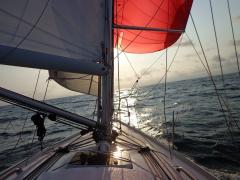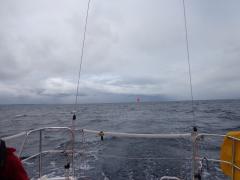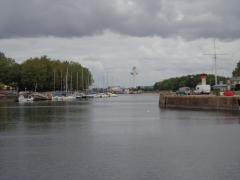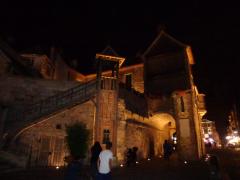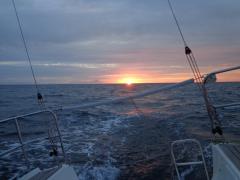When the boat behind appears to be featuring in a sort of meteorological apocalypse, it's a good moment to drop the kite. 'On affale, en urgence!' I shouted forward to Georges, who did just that. We were approaching the buoy anyway, and the 30-knot squall hit just as we rounded...
The slightly early drop was part of the game plan not to invite problems, and the last leg was a short tight reach, which meant we maintained the lead we had had all the way from Saint-Vaast to Ouistreham, mostly under spinnaker in an average of 15 knots dead astern, trying not to gybe - the boat that did gybe, twice, arrived at Ouistreham with its kite tightly wrapped round the forestay!
The result restored our faith in the boat, Georges' Winner 9m 'Crazy Goose', with new jib and magic barber-haulers enabling a lot of height and speed upwind, with which on the first leg from Fécamp to Courseulles we had already managed a second, but on the leg up to Saint-Vaast seemed to be going slower and slower – the dreaded weed on the rudder, prop or keel. Bernard from the Sigma dived at Saint-Vaast to ensure both boats were clear, but missed a short length of fishing line on ours; because it's a feathering prop, this was enough to jam the prop after motoring, rather than allow it to align itself, so that for the short race the next evening which was all the calm conditions permitted we were even slower, so Georges dived again that evening just before it got dark and fortunately discovered the problem.
With two poor results and one good one, we had to raise our game, and the second place result on corrected at Ouistreham showed we were back. The start the next morning in rough conditions was difficult, but we managed to find a hole at the committee boat end and get away fast and high and thus finish the first short windward leg ahead of the others and make some time on the long reach out to sea, where we shook out the reef and extended the lead a bit.
We were heading for Honfleur via the buoy marking the end of the Le Havre channel, which meant more dead downwind with an increasing wind, so we resisted the temptation to set a kite, not wanting to have to gybe in the narrow Rouen channel in more than twenty knots, which against the ebb current produced an increasingly awkward sea, making the wait for the lock to open at Honfleur a long one as another rain squall approached from the west. The chance to visit Honfleur was much appreciated; completing my set of ports in this part of Normandy, though it is not an easy place to get to.
The Sigma had opted for a long spinnaker reach into the bay just before Le Havre and gybed on to a starboard reach, though it became evident that this strategy was based on an error as they left out a mark, and had to retire when they realised. Our conservative approach gained us a first, which left everything to play for on the final day, coming back from Honfleur to le Havre.
Another difficult start against the current in not very much wind meant we found ourselves on the left hand side of the beat out of the estuary, and a combination of lucky wind shifts put us well ahead – for about half an hour we were leading the fast class as well, until the SunFast 3200 and the J92 finally caught up, just before another 30-knot squall, a fairly regular feature of the week, which put the boat on its ear for a few minutes, though we recovered to be able to set the big kite albeit in difficult conditions with little wind for a while, until it finally filled in and we finished first again, though were second on corrected time, giving us second place in class on countback to the Sigma.
Ashore at Le Havre we joined the party for the start of the Figaro Solitaire, using their podium for our prizegiving before a final meal at the Paul Vatine clubhouse and an early night before leaving at 2 am to return to Saint-Vaast on Sunday morning – even so the wind had got up to 20 knots as we reached into from the Iles Saint-Marcouf to end another great Normandy adventure. That evening felt like November as the wind reached gale force and the rain fell...
Since then I've been involved in the World University Sailing Championship here - a rather more modest event than its name suggests, though with a range of teams from around the globe racing in groups in the twelve J80s provided; I was helping Gilles on his boat, taking out coaches to watch and debrief their crews between races - on one side Marco the Italian coach would be giving advice in Italian, while at the same time on the other it might be Manolo doing the same in Spanish, or Cai from Singapore coaching in English.
This week it's been tidy up the boat and try to do some work, as well as racing on the Sigma on Thursday, and driving a J22 on Friday evening for the restart of evening racing at both clubs. Making a competitive start as the smallest boat in a mixed fleet of 24 boats in a brisk wind was not easy, but we found a hole to get to windward of the rest and set the kite to keep us well up with the bigger boats, finishing with a good second place on corrected. A J22 is a bit like a supercharged Squib, I discovered, feeling reasonably at home quite quickly.
After this week's racing it will be time to think about returning to Weymouth; having visited around ten clubs here in the course of the season's events, I feel there are ideas we might look at to try to develop even further Weymouth's provision for sailing as we enter a new era...
Submitted on 9th September 2018
